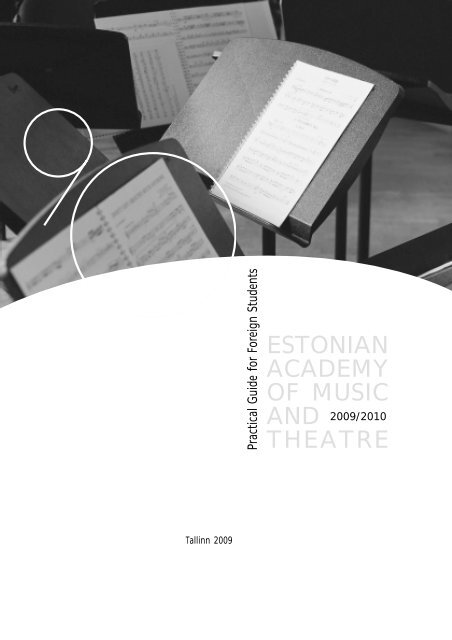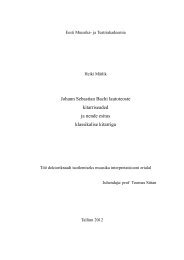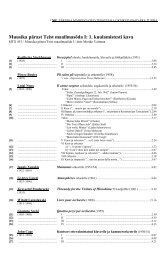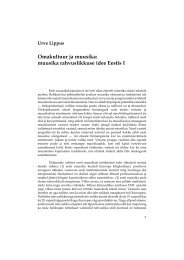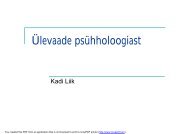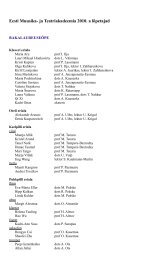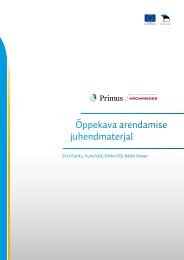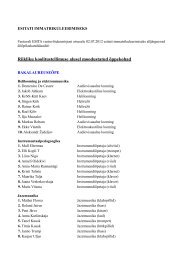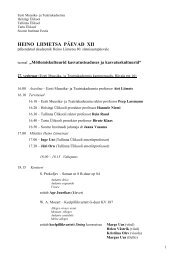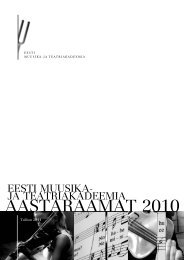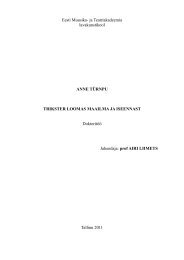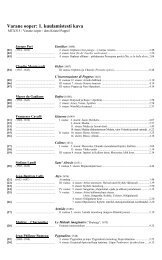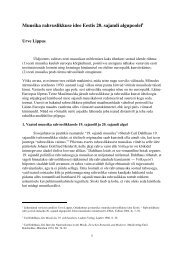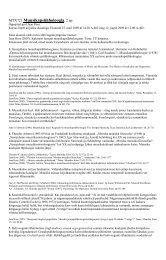Create successful ePaper yourself
Turn your PDF publications into a flip-book with our unique Google optimized e-Paper software.
Practical Guide for Foreign Students<br />
<strong>ESTONIAN</strong><br />
<strong>ACADEMY</strong><br />
<strong>OF</strong> <strong>MUSIC</strong><br />
<strong>AND</strong> 2009/2010<br />
<strong>THEATRE</strong><br />
Tallinn 2009
2<br />
Published by Estonian Academy of Music and Theatre<br />
Compiled by Maria Mölder<br />
Linguistic Editor Hanneleen Pihlak<br />
Photos by Kaido Haagen, Andres Rohtla<br />
Designed by Andres Rohtla
WELCOME!<br />
Thank you for choosing the Estonian Academy of Music<br />
and Theatre, the only Estonian public university that<br />
offers higher education in music but also in theatre.<br />
In 2009, EAMT celebrates its 90 th anniversary. In addition<br />
to preserving conventional traditions, the academy has<br />
been searching for new ways to adapt to the modern<br />
methods of teaching. During recent decades, EAMT has<br />
developed into a contemporary study environment.<br />
This guide is designed to help you to plan your stay and<br />
studies in Tallinn. It includes practical information that<br />
will be of use when organizing your arrival and life<br />
here. We hope that your stay in Estonia will be beneficial<br />
and pleasant.<br />
Peep Lassmann<br />
Rector<br />
3
TABLE <strong>OF</strong> CONTENTS<br />
1. FIRST TIME IN ESTONIA 5<br />
The Country and Its People 5<br />
Climate 5<br />
History 6<br />
Historical Tallinn 6<br />
Music of Estonia 7<br />
Theatre Tradition of Estonia 8<br />
2. <strong>ESTONIAN</strong> <strong>ACADEMY</strong> <strong>OF</strong> <strong>MUSIC</strong> <strong>AND</strong> <strong>THEATRE</strong> 10<br />
Introduction 10<br />
History 10<br />
Statistics 11<br />
The Study System 12<br />
Degree and Non-Degree Programmes 12<br />
European Credit Transfer and Accumulation System 12<br />
Language of Instruction 13<br />
Admission Rules 13<br />
Tuition Fees 14<br />
International Relations 14<br />
Partner Schools 16<br />
Concerts and Performances 19<br />
Student Council 21<br />
Adviser of the Foreign Students 21<br />
Library 22<br />
Cafeteria 23<br />
Concerto Grosso Music Shop 23<br />
4<br />
3. LIVING IN TALLINN 24<br />
Residence Permit and Visa 24<br />
Map of Tallinn 24<br />
Public Transport 24<br />
Taxi 25<br />
Student Dormitory 25<br />
Flat Rental 25<br />
Hostels 25<br />
Hotels 26<br />
This and That 27<br />
Money 27<br />
Medical Care 28<br />
Post Offices 28<br />
Phone Calls 28<br />
Emergency Service 28<br />
Electricity 28<br />
Sport Facilities 28<br />
Bicycle Rent 28<br />
Public Holidays 28<br />
Tourist Information 29<br />
Cultural Information: Music and Theatre 29<br />
4. CONTACTS <strong>OF</strong> EAMT 32
FIRST TIME IN<br />
ESTONIA<br />
The Country and Its People<br />
Estonia is situated in Northern Europe, on the eastern coast of the Baltic Sea. The territory<br />
of Estonia is 45,227 sq km and with only 1 342 409 inhabitants (January 2007), it comprises<br />
one of the smallest populations of the EU countries. Population density is an average of 30<br />
people per sq km compared to 116 per sq km, the average in the EU. Estonians constitute<br />
68% and Russians around 29% of the population; the number of Ukrainians, Belorussians,<br />
Finns and the representatives of other nations is smaller. The official language is Estonian;<br />
part of the population has a good command of Russian and English. In addition, Võro and<br />
Seto dialects are spoken in southern counties, other local dialects are not so viable anymore.<br />
Ethnically and linguistically, Estonians belong to the Finno-Ugric peoples; Estonian is<br />
spoken by approximately one million people all over the world.<br />
Due to its history and geography, Estonia’s culture has been mainly influenced by the<br />
traditions of various Finnic, Baltic and Germanic peoples. The main religion is Lutheran;<br />
Orthodoxy, the Baptist tradition, and several other religions are represented as well.<br />
One of the biggest riches of Estonia is its diverse and rather untouched nature. Over 1 400<br />
lakes and numerous bogs dot the countryside, which is relatively flat and nearly halfcovered<br />
with forest, full of animal species that are rare elsewhere in Europe. The highest<br />
point is Suur Munamägi, 318 m above sea level. There are around 1 500 islands off of<br />
Estonia’s coast, two of them (Saaremaa and Hiiumaa) are large enough to form separate<br />
counties.<br />
The largest towns are the capital Tallinn, Tartu, Narva and Pärnu. Estonia has a 633 km land<br />
border; 339 km of it with Latvia and 294 km with Russia. Closest cities beyond Estonian<br />
border are Helsinki, Stockholm, St. Petersburg and Riga.<br />
Climate<br />
Estonia lies nearly at the same latitude as Southern Alaska, but thanks to the influence of<br />
the Gulf Stream, the climate is mild, characterized by warm summers and fairly severe<br />
winters. Despite the advantage of experiencing all four seasons, Estonians have a jocular<br />
expression that it is bad skiing weather all the year round. True – the weather is often<br />
breezy and humid due to the proximity of the Baltic Sea. The average annual temperature<br />
5
in Estonia is 5.2°C. Average temperatures range from 16.4°C in summer (usually July is the<br />
hottest month) to –8°C in winter. Occasionally the temperature may rise to 30°C and above<br />
in summer or sink below –23°C in winter. There are about 160 to 190 rainy days a year.<br />
History<br />
Estonians are one of the most “local” nations in Europe, the first inhabitants settled in this<br />
territory about 8500 BC. Estonians were first mentioned in the 1 st century by the Roman<br />
historian Tacitus and the country was first mapped in 1154 by the Arab geographer al-<br />
Idrisi. The present international name Estonia is derived from Latin.<br />
Estonians were one of the last pagan peoples in Europe. People began raising cattle and<br />
cultivating the land already 2000 BC. As Viking sagas refer, Estonian pirates were well<br />
known to Scandinavians in the early Middle Ages. The year 1227 denoted the beginning of<br />
the German-Scandinavian colonization. The conquerors brought along Christianity, new<br />
economic relations and Germanic culture, which exercised profound influence on the<br />
society well into the beginning of the 20 th century, including the periods Estonia was ruled<br />
by several foreign powers.<br />
In the 1520s, Lutheran ideas began to spread in the territory of Estonia. The Reformation<br />
was followed by a long period of wars and rules of different states (Russia, Poland, Sweden<br />
and Denmark).<br />
As a result of the abolition of serfdom in 1816, the movement of National Awakening<br />
developed in the mid-19 th century and some improvements were brought to the living<br />
environment and cultural sphere. After the collapse of Russian tsarism, Estonians fought in<br />
the War of Independence (1918–1920) against Russian communists and Landeswehr, the<br />
Baltic German militia. On February 24 th , 1918, the Republic of Estonia was proclaimed and<br />
for the first time, Estonian own parliament was formed. In 1921, Estonian nation state<br />
became a member of the League of Nations.<br />
Estonia kept its independence until the secret pact between German and Soviet authorities,<br />
which resulted in the occupation of Baltic States in 1939. Most of the Second World War,<br />
Estonia was controlled by German occupants. After the war in 1945, the country was again<br />
taken over by Soviet Union and the occupation lasted for about half a century.<br />
In the course of events of the coup d’etat attempt in Moscow in August 1991, Estonia was<br />
declared independent. Since September 17, 1991, Estonia has been a member of the<br />
United Nations. Estonia joined NATO on March 29 th , 2004, and the European Union on May<br />
1 st , 2004.<br />
Historical Tallinn<br />
6<br />
Probably already in the 9 th century, ancient Estonians built an earthen stronghold on the<br />
today’s Toompea hill near a suitable port site. The castle developed into the centre of the<br />
ancient Rävala County. However, first traces of human settlement found in Tallinn’s city<br />
centre by archaeologists are about 5000 years old.<br />
Extensive building began after the Northern Crusades early in the 13 th century. Following<br />
the examples of Northern Germany, massive stone churches, bishop and order castles were<br />
erected. In the 13 th century, Danish conquerors began building the Town Wall, which, as a<br />
result of 300 years of development, became one of the strongest defensive structures of its time.
In 1285, Tallinn joined the Hanseatic League. The Danes sold Tallinn along with their other<br />
land possessions in northern Estonia to the Teutonic Knights in 1346. As all the trade<br />
routes between Western European Hanseatic towns and the Russian territory went through<br />
Tallinn, the wealth and population of the town grew rapidly. Architecture was developing,<br />
achieving its peak in the 15 th century. During that period, Tallinn’s Town Hall, St. Nicholas<br />
and St. Olav’s Church and other remarkable works of Gothic architecture were erected.<br />
Medieval residential houses, situated in a line right next to each other, had high gable roofs<br />
and pointed arch portals. The needle-sharp church towers rising above the buildings add<br />
elegance to the silhouette of the town. Tallinn is the best-retained medieval town in the<br />
Northern Europe, preserved nearly in its entirety. In 1997, UNESCO included the Old Town<br />
of Tallinn on its World Heritage List.<br />
Protestant Reformation cultivated the German influence even more than earlier as the city<br />
was converted to Lutheranism. In 1561, Tallinn politically became a dominion of Sweden.<br />
There are very few examples of Renaissance (the House of the Brotherhood of Black Heads)<br />
and Baroque style (the Kadriorg Palace) in the architecture. The urban palaces of aristocrats,<br />
which were built following the example of the Classicist architecture of the tsarist Russia<br />
gave a new air to Toompea hill.<br />
The 20 th century introduced Jugend or Art Nouveau (the Estonian Drama Theatre) and the<br />
21 st century brought Modernism (the new building of St. Bridget’s Convent, the Museum<br />
of Occupations, Kumu) into Estonian architecture.<br />
FIRST TIME IN ESTONIA<br />
Music of Estonia<br />
The oldest form of Estonian folk music (runic song) dates from the First Millennium and<br />
this tradition has been kept vital up to the present day. Runic singing was widespread<br />
among Estonians until the 18th century when it started to be replaced by rhythmic<br />
folksongs.<br />
Middle Ages brought along European musical culture: the Gregorian chant, organs and<br />
town musicians. In the 16 th century, Lutheran chorale singing became predominant. In the<br />
18 th century, chorales arranged for several voices were sung in the fraternities.<br />
Estonians are often called a singing nation, most of them sing in a choir and the country<br />
has a long tradition of song festivals. In the wind of significant social and cultural changes<br />
in the mid-19 th century, many choirs and brass bands were founded in every region of<br />
Estonia. Two of the music societies, Estonia in Tallinn and Vanemuine in Tartu (both<br />
founded in 1865) later became important as professional theatres and concert organizations.<br />
The first song festival took place in Tartu in 1869 and nowadays these uniting celebrations<br />
are organized regularly at Tallinn’s Song Festival Grounds with participants wearing<br />
colourful national costumes. In some periods the preserved tradition of song festivals has<br />
acquired political meaning; this culminated at the end of 1980s with the “Singing<br />
Revolution”.<br />
At the end of the 19 th century, the first Estonian professional musicians Johannes Kappel,<br />
Miina Härma and Konstantin Türnpu acquired their education at the St. Petersburg<br />
Conservatoire.<br />
After Estonia became independent, musical education and professional music culture in<br />
Estonia got into full swing. The founder of national symphonic music was Rudolf Tobias:<br />
in 1900, the first Estonian symphony orchestra was created in Tartu and the first Estonian<br />
symphony was written by Artur Lemba. Monumental composing style was characteristic<br />
7
also to Artur Kapp. A development towards national originality began with the works of<br />
Mart Saar, Cyrillus Kreek and Heino Eller. During the first two decades of the 20 th century,<br />
Estonian music went through the development of the entire Western music history from<br />
classical to modern European trends. In 1919, higher music schools were established in<br />
Tallinn and Tartu, both laying the foundation to an idiosyncratic school of composers.<br />
Due to the unstable political situation, many leading musicians, including the distinguished<br />
symphonic composer Eduard Tubin, fled Estonia in 1944. Despite the years of russification,<br />
national identity and creative aspirations could be maintained in Estonia. In mid-1950s,<br />
composers with a more modern mode of expression emerged: Ester Mägi, Eino Tamberg,<br />
Jaan Rääts, Arvo Pärt, Veljo Tormis, etc. In the 1960s, the work of Uno Naissoo formed the<br />
basis for Estonian jazz music. The 1970s introduced a new generation of composers, the<br />
best known of them today are Lepo Sumera, Raimo Kangro, Erkki-Sven Tüür and Urmas<br />
Sisask.<br />
Most of the contemporary composers have their idiosyncratic style that borrows<br />
characteristic qualities from very different streams. The style of elder composers is more<br />
established while the younger ones have more experimental enthusiasm. The music of<br />
younger composers quite frequently reveals meditative and ritualistic features, dreamlike<br />
moods and a particular sensitiveness. To name only few, Estonian music is richer thanks to<br />
Helena Tulve, Toivo Tulev, Mirjam Tally, Jüri Reinvere, Tõnis Kaumann, Mari Vihmand, Galina<br />
Grigorjeva, Tõnu Kõrvits and Märt-Matis Lill who have made a relevant contribution in the<br />
recent decade.<br />
Thanks to successful conductors such as Neeme Järvi, Eri Klas, Arvo Volmer, Tõnu Kaljuste<br />
and Olari Elts, Estonian music can be heard worldwide more often. In addition to conductors<br />
and many individual performers, several musical collectives travel round the world<br />
performing Estonian music: NYYD Ensemble (contemporary music ensemble led by Olari<br />
Elts), Estonian Philharmonic Chamber Choir, Estonian National Symphony Orchestra, Hortus<br />
Musicus (early music ensemble led by Andres Mustonen), the Estonian National Male Choir,<br />
Tallinn Chamber Orchestra, Vox Clamantis (gregorian chant ensemble led by Jaan-Eik<br />
Tulve), etc.<br />
Theatre Tradition of Estonia<br />
8<br />
The historical roots of Estonian theatre have been said to date back to the games and<br />
rituals of the Estonian folklore. However, national theatre evolved by the influence of<br />
German culture in the 1870s, playing a huge role in the Estonian national awakening<br />
movement. In 1890, a resident professional theatre was established in Tallinn and performed<br />
mostly in German. In 1906, the first professional Estonian repertory company, the<br />
Vanemuine, was opened in Tartu, followed by the Estonia company in Tallinn later that<br />
year and the Endla company in Pärnu in 1911.<br />
Only in the independent Republic of Estonia (1918-1940), Estonian theatre reached the<br />
professional level of the European theatres. Estonian theatres were (and still mostly are)<br />
repertoire theatres and in the country with a population of 1 million, the 11 theatres (in<br />
1940) were at least partially state subsidized. The country’s first opera and ballet troupes<br />
were also opened in that period.<br />
When Estonia was annexed by the Soviet Union in 1940, theatres were nationalized and<br />
the repertoire was inundated with Soviet plays, brought out under tight administrative<br />
and ideological control, to exclude western influences among other things. However,
though many theatres lay in ruins due to the war, the basic theatre network remained and<br />
during the 1960s and 1970s when the ‘thaw’ in the artistic and intellectual life began and<br />
the repertoire widened, theatres turned into one of the strongest sources for cultural<br />
preservation and struggle against foreign power. The most prominent theatre figures of<br />
that period were Voldemar Panso, the founder of the Noorsooteater (Youth Theatre, 1965)<br />
in Tallinn and a long-time leader of Higher Drama School, and Kaarel Ird who led the<br />
Vanemuine.<br />
In 1969, the first wawe of theatre innovation, a new and radical style of staging and acting,<br />
connected with the names of young directors Jaan Tooming and Evald Hermaküla, both at<br />
the time working in the Vanemuine of Tartu, made its appearance. It manifested itself in<br />
the freedom with which play texts were often treated, in the aggressiveness and physicality<br />
of stage action, and in heavy reliance on symbols and metaphors. In retrospect it looks<br />
surprising how well the movement harmonized with current international trends, whose<br />
actual productions Estonian directors had been unable to see, and how exceptional it was<br />
against Soviet background.<br />
The highest annual number of theatre visitors reached 1,7 million, although after regaining<br />
the independence in 1991, the number never reached that level again. After the perestroika<br />
(restructuring) in 1985, censorship was suddenly abolished; many subjects, authors and<br />
plays previously banned were now able to reach the stage. However, the number of<br />
theatres covered by the state subvention has not diminished and smaller, private theatres<br />
have emerged into the Estonian theatre scene. At present, theatre is still one of the most<br />
popular cultural spheres in Estonia and Estonian theatres perform successfully at the<br />
international theatre festivals.<br />
Theatre education in Estonia has been quite irregular. One of the most relevant early<br />
educational centres was the Higher Theatre School of the Tallinn Conservatoire, which was<br />
opened in 1938, but could only function until the German and Soviet occupations. The<br />
National Theatre Institute of Estonia, established in Tallinn in 1946, had to close its doors<br />
in 1950/51 during the so-called anti-nationalist repressions and thus only 3 classes were<br />
able to graduate. After that, theatre students studied at the Estonian Studio at the Institute<br />
of Theatre Arts of Moscow (1948-1953) for some time, until the first group of actors<br />
graduated (1961) from the refounded Higher Theatre School of the Tallinn State<br />
Conservatoire (1957), today’s Drama School of EAMT.<br />
After the death of Voldemar Panso, the first headmaster (1957-1977) of the present day<br />
Drama School, many of his students have held teaching and headmaster positions at the<br />
school. The Drama School has mainly been oriented towards the education of actors, but<br />
many renown directors of the present-time have also graduated from the school, and<br />
nowadays, separate admissions to the directing studies are held. In 2004, dramaturgy<br />
students were admitted to the school for the first time. The graduates work in all Estonian<br />
theatres as well as in television, radio, cinema, etc. The drama lecturers of other Estonian<br />
universities have also sprung from the Drama School of EAMT.<br />
FIRST TIME IN ESTONIA<br />
9
<strong>ESTONIAN</strong><br />
<strong>ACADEMY</strong><br />
<strong>OF</strong> <strong>MUSIC</strong><br />
<strong>AND</strong><br />
<strong>THEATRE</strong><br />
Introduction<br />
During recent decades, EAMT has gone through a lot of changes and development, which<br />
includes creating new departments and specialities. While the main focus of EAMT is still<br />
on classical music and instrumental studies, accompanied by dramatic art, the academy<br />
today offers a number of other possibilities.<br />
Estonia has a strong piano tradition, but the same department also teaches harpsichord<br />
and organ. The string instruments include violin, viola, cello, double bass, harp and<br />
classical guitar. Among the wind instruments, flute, oboe, clarinet, bassoon, saxophone,<br />
French horn, trumpet, trombone and tuba are taught in EAMT, percussion<br />
instruments are in the same department. In the voice department it’s possible to study<br />
both opera singing and vocal chamber music. Conductors get different training to<br />
work with choirs, wind ensembles or orchestras. The skills of playing in chamber<br />
ensemble and accompanying other musicians are taught as well.<br />
The composition department nowadays incorporates the classical art of composing music<br />
and the specialities of electronic music and sound engineering that are taught in the<br />
electronic music studio. Musicology studies give an overview of different subdivisions of<br />
musicology (music history, music theory, ethnomusicology, cognitive musicology etc.);<br />
musicologists of EAMT also give an outstanding scholarly contribution. Jazz music<br />
department educates both jazz and folk musicians. Piano, strings, brass and woodwind<br />
instruments, recorder, accordion and Estonian zither called kannel are also taught in the<br />
Tartu branch of EAMT. Institute of interpretation pedagogics deals with educating<br />
musical instrument teachers while music education institute educates music teachers<br />
for elementary schools and high schools. Continuing education centre makes it possible<br />
to educate already active music teachers and organize master classes. The cultural<br />
management master’s programme with its guest lecturers has the most international<br />
dimension in Estonia, the same department co-ordinates the humanity subjects of the<br />
academy as well. The Drama School of EAMT educates the most dashing part of actors,<br />
stage directors and now also dramatists of Estonian theatre.<br />
10<br />
History<br />
Tallinn Higher Music School (nowadays Estonian Academy of Music and Theatre) was<br />
founded in 1919, only a year after Estonia was proclaimed independent. 383 students were<br />
admitted to the school and the teaching staff comprised of 28 teachers, most of whom<br />
had acquired their education at St. Petersburg Conservatoire. The first principal of the<br />
school was composer Mihkel Lüdig.
In 1923, the educational institution was renamed Tallinn Conservatoire. In 1925, the first<br />
own professors were elected: Raimund Bööcke, Artur Kapp, Johannes Paulsen, Peeter Ramul<br />
and August Topman. The same year, ten first musicians graduated. The academic level of<br />
the Conservatoire soon rose relatively high, as many students participated in international<br />
competitions in the 1930s. Originally a private institution, the Conservatoire was nationalized<br />
in 1935. In 1938, the State Drama School was opened.<br />
The occupation that began in 1940, seriously hampered teaching. The building of the<br />
Conservatoire was almost completely destroyed during the air raid of March 1944. Teaching<br />
was carried out in the difficult conditions of war and all the political storms that followed.<br />
The teaching staffs of the Conservatoire have included most of the distinguished Estonian<br />
musicians, e.g., Gustav Ernesaks, Heino Eller, Cyrillus Kreek, Hugo Lepnurm, Bruno Lukk and<br />
many others.<br />
In 1957, the Drama Faculty was opened in the Conservatoire, and Voldemar Panso became<br />
its first head. During the 1970s, the organ class, which had been closed in 1950, was<br />
reopened. In 1971, a programme to train music educators for work in the comprehensive<br />
school system was resumed.<br />
After Estonia regained its independence in 1991, an extensive reform of teaching was<br />
started and academic degree programmes were introduced. In 1992, Peep Lassmann was<br />
elected rector. In 1993, Tallinn Conservatoire was renamed the Estonian Academy of Music.<br />
During the years 1987–1993 extensive renovation and reconstruction took place in the<br />
building of the Drama Faculty. The faculty started to use the entire two-story building. In<br />
1995, the Drama Faculty was renamed the Higher Drama School.<br />
In 1997, Tartu branch of EAMT was founded.<br />
For more than half a century, teaching was carried out in different temporary classrooms<br />
providing conditions not suitable for studying. In 1999, the Estonian Academy of Music<br />
finally got a new building, with technical solutions and acoustic conditions entirely<br />
meeting the requirements of a higher music education.<br />
In 2005, the Estonian Academy of Music was renamed the Estonian Academy of Music and<br />
Theatre. Since then the academy has concentrated on deepening international co-operation,<br />
the school has more foreign lecturers and students than before. Several professors, and<br />
other people lecturing and studying at the Estonian Academy of Music and Theatre have<br />
gained international recognition.<br />
In 2009, Estonian Academy of Music and Theatre celebrates its 90 th anniversary.<br />
<strong>ESTONIAN</strong> <strong>ACADEMY</strong> <strong>OF</strong> <strong>MUSIC</strong> <strong>AND</strong> <strong>THEATRE</strong><br />
Statistics<br />
As of September 10, 2008, there are 690 students at EAMT (482 in the Bachelor Studies,<br />
168 in the Master Studies, and 40 in the Doctoral Studies).<br />
In 2008, 134 students graduated from the Academy (66 from the Bachelor Studies, 65<br />
from the Master Studies, and 3 from the Doctoral Studies), 218 student candidates were<br />
admitted (122 to the Bachelor Studies, 87 to the Master Studies, and 9 to the Doctoral Studies).<br />
35 students of the Academy are studying in Europe’s different higher education institutions<br />
in music within the framework of the LLP ERASMUS student exchange programme (2008/2009).<br />
EAMT includes a teaching staff of 280, of which 133 are engaged on a contractual (hourly)<br />
basis; in addition there are 14 emeritus professors and 7 emeritus associate professors.<br />
Many professors are employed part-time. The total number of full-time academic positions<br />
is about 100. The Academy employs 23 piano accompanists and 11 researchers. The number<br />
of administrative workers and support personnel is 92.<br />
11
The Study System<br />
The studies at EAMT take place mainly according to the subject system. This means that<br />
the content and length of studies are determined at least partly by the students themselves.<br />
In case of full-time studies, the compulsory curriculum volume per one academic year<br />
is 60 ECTS credits. Students can choose the subjects from the subject catalogue that is<br />
available online: www.ema.edu.ee/index.phpmain=609 (please note that only part of the<br />
courses are taught in English).<br />
For every main study area, there is a model study programme that needs to be completed.<br />
Obligatory subjects for instrumentalists usually include the main study (on an average two<br />
individual classes per week), chamber ensemble, symphony orchestra or opera studio,<br />
music history, music theory and some general humanities.<br />
Elective subjects constitute at least 15% of the total curriculum. In addition to regular<br />
studies, many master classes take place.<br />
Degree and Non-Degree Programmes<br />
EAMT awards degrees on three levels:<br />
1. A full-time four-year undergraduate programme leading to a Bachelor Degree:<br />
BA in Humanities or BA in Education.<br />
2. A full-time one- or two-year graduate programme leading to a Master’s Degree:<br />
MA in Arts, MA in Education or MA in Humanities.<br />
3. A full-time four-year postgraduate programme leading to a Doctoral Degree:<br />
PhD in Music Performance and Composition, PhD in Musicology, PhD in Music<br />
Pedagogy or PhD in Dramatic Art.<br />
Independent and non-degree programmes of study may be agreed upon between<br />
individual students and the Academy. This independent study option is suitable for students<br />
who want to improve themselves in some specific areas and do not wish to complete an<br />
entire degree programme.<br />
EAMT is now in a phase of transition: the changeover to 3+2 system (Bachelor Degree +<br />
Master’s Degree) will start in Autumn 2009.<br />
European Credit Transfer and Accumulation System<br />
12<br />
The credit point system used in Estonia corresponds to the European Credit Transfer and<br />
Accumulation System (ECTS). ECTS is a student-centred system based on the student<br />
workload required to achieve the objectives of a programme, objectives preferably specified<br />
in terms of learning outcomes and competencies to be acquired.<br />
ECTS makes study programmes easy to read and compare for both local and foreign<br />
students. ECTS facilitates mobility and academic recognition. ECTS helps universities organize<br />
and revise their study programmes. ECTS can be used across a variety of programmes and<br />
modes of delivery. ECTS makes European higher education more attractive for students<br />
from other continents.
ECTS is based on the convention that 60 credits compile the workload of a full time<br />
student during one academic year. One credit point stands for 26 working hours of a<br />
student. Student workload in ECTS includes time spent in attending lectures, seminars,<br />
independent study, preparation for and taking examinations, etc.<br />
ECTS Grading Scale<br />
A (5) excellent<br />
B (4) very good<br />
C (3) good<br />
D (2) satisfactory<br />
E (1) sufficient<br />
F/FX (0) fail<br />
Language of Instruction<br />
The official language of instruction at EAMT is Estonian. It is also possible to have individual<br />
lessons in English, German, French, Russian and Finnish. Several courses (music theory,<br />
music history) are taught in English for foreign students. Full-time degree studies in<br />
Drama School are possible in Estonian only.<br />
EAMT offers special courses for foreign students to learn Estonian.<br />
Admission Rules<br />
All applicants who reside permanently in Estonia or in other countries of the European<br />
Union can apply to the state-financed and the fee-based studentships on equal basis.<br />
Citizens of third countries, who don’t have a permanent residence permit of some country<br />
of the European Union can apply only to the fee-based studentships.<br />
A student candidate to the Academy shall present the following documents to the Admission<br />
Committee:<br />
- an application<br />
- a document certifying the completion of the previous educational level with<br />
a certificate with grades or diploma supplement (both the original and a copy);<br />
- 3 photos (3x4 cm);<br />
- an identity card or a passport with a copy of the corresponding document’s page<br />
that carries the personal identification code;<br />
- document certifying change of name, if the applicant has had a name change<br />
(both the original and a copy);<br />
- in case of applying to Doctoral Studies, a prospective plan of studies (the subject<br />
of the Doctoral Thesis, its realization plan, ideas for performance programmes).<br />
<strong>ESTONIAN</strong> <strong>ACADEMY</strong> <strong>OF</strong> <strong>MUSIC</strong> <strong>AND</strong> <strong>THEATRE</strong><br />
As a rule, a student candidate may apply to one area of specialization at a time.<br />
Any documents issued outside Estonia must be presented either in Estonian or in English.<br />
The Admission Committee shall decide about approving documents certifying education<br />
in foreign states, if necessary the Committee shall base their decision on the estimation<br />
and evaluation of the ENIC/NARIC centre in Estonia.<br />
13
Entrance examinations are held at the end of June.<br />
The Drama School carries out the preliminary rounds of the entrance examination during<br />
the spring semester.<br />
The entrance to cultural management and drama school is announced every other year. The<br />
academical year usually starts at the end of August. More precise material about the<br />
admission and examination process is found at<br />
www.ema.edu.ee/index.phpmain=620.<br />
Tuition Fees<br />
Student candidates who are offered fee-based studentships must present a written<br />
application, expressing their wish to start studies, to the Secretary of Admission within a<br />
week after the end of the entrance examinations; and sign an education contract with the<br />
Academy within one week before the beginning of the academic year.<br />
The Academic Council of EAMT may increase the tuition fees up to 10% from one academic<br />
year to the next.<br />
Valid tuition fees can be found at EAMT website:<br />
www.ema.edu.ee/index.phpmain=611.<br />
International Relations<br />
14<br />
Estonian higher music education has always been international to a greater or lesser<br />
extent. At the beginning of 20 th century our very first music professors were educated<br />
foremost in St. Petersburg, but also in Moscow, Berlin, Dresden, London and other European<br />
music metropolises. Since 1991 there has been a significant change in the political landscape<br />
and an explosive growth of the international relations towards the form the academy<br />
nowadays works with as an active and equal partner on the international higher education<br />
scene.<br />
Today EAMT belongs to different co-operation networks, such as the Association of European<br />
Conservatoires (AEC), the European League of the Institutes of Arts (ELIA), the Association of<br />
Baltic Academies of Music (ABAM) and the Network of International Cooperation Activities<br />
(NICA). In three of those, the EAMT has been selected a board member: rector Peep Lassmann<br />
is a member of the AEC board and vice president of the ABAM, and since 2004, vice rector<br />
Marje Lohuaru is on the board of ELIA. The participation of EAMT in the governing<br />
structures of these networks allows the academy to have a say in the strategic questions of<br />
the development plans of European higher education in arts. After the establishment of<br />
the cultural management master course, EAMT is a member of European Network of<br />
Cultural Administration Training Centres (ENCATC) and The International Association of<br />
Arts and Cultural Management (AIMAC). Since the year 2004, EAMT has been the member<br />
of International Association of Schools of Jazz (IASJ). EAMT is a leading partner institution<br />
for the artesnet Europe: this is an Erasmus Thematic Network of ELIA that promotes<br />
projects in partnership between creative enterprise and local communities, also contributes<br />
to the 2009 European Year of Creativity, Culture and Education.<br />
During the last decade EAMT has worked with many international co-operation programmes:<br />
PHARE-TEMPUS five multi-annual projects during 1994-2001, SOCRATES Curriculum<br />
Development and SOCRATES Intensive Projects (as partner and as coordinator), Culture
2000, Leonardo programme, US Fulbright Programme, Japanese Government Cultural Aid<br />
Program and others.<br />
EAMT has recently been a partner in European Course for Musical Composition and<br />
Technologies in the framework of Leonardo da Vinci programme that focuses on combining<br />
the fields of research, creation and teaching. The project aims to gather the multiple<br />
competences of different European institutions dealing with contemporary music and<br />
technologies. Many programmes have had a catalyst role in opening new specialties –<br />
PHARE-TEMPUS and Japanese Government Cultural Aid Programme allowed to open the<br />
electronic music and sound engineering speciality, UNESCO grant assisted for opening the<br />
arts management master degree programme, US Fulbright and Erasmus programme have<br />
had a significant role in the development of the jazz music department.<br />
Since the academic year 1999/2000, EAMT has actively participated in the European Union<br />
Erasmus (former SOCRATES) programme involving the exchange of students and academic<br />
staff with partner universities from Europe. The yearly number of outgoing students is<br />
about 30. Starting from 2009, EAMT offers exchange possibilities for students and lecturers<br />
through Nordplus Framework Programme, a network involving Nordic and Baltic music<br />
schools.<br />
Staff exchange has made it possible to take part in and organize master classes of wellknown<br />
professors from all over Europe. Additionally EAMT participates in different student<br />
scholarship programmes that allow the students to visit master classes, play in orchestras<br />
all over the world and be involved in many other speciality activities.<br />
Different projects have brought very lively activity and events to EAMT. Since 2005, EAMT<br />
has developed LLP ERASMUS IP (Intensive Programme) courses that deal with classical and<br />
contemporary music, jazz and improvisation. The courses bring together students and<br />
professors from Association of Baltic Academies of Music (ABAM). The project is co-ordinated<br />
by EAMT and there are 9 partner schools.<br />
First summer course “Crossing Borders in Interpretation of Classical Music and Jazz” took<br />
place in August 2005, with the focus on new interpretation trends in classical music and<br />
jazz. Next year, the Academy organized a summer course “Crossing Interpretation Borders<br />
again: Improvisation and Contemporary Music” which introduced new trends of<br />
improvisation. In August 2007, the Academy held a third summer course “Crossing Borders<br />
once more: Synthesis of Different Approaches in Interpretation”, this time connecting the<br />
teaching methods of classical music, improvisation, contemporary music and jazz. After<br />
that a DVD and an overview publication that included articles by many professors was<br />
published. The courses gained the attention of European Commission responsible for<br />
Education, Training, Culture and Youth: Crossing Borders courses were named a European<br />
Success Story. In January 2009, the project continued with a winter course “Innovative<br />
Approaches in Interpretation of Music”.<br />
<strong>ESTONIAN</strong> <strong>ACADEMY</strong> <strong>OF</strong> <strong>MUSIC</strong> <strong>AND</strong> <strong>THEATRE</strong><br />
15
Partner Schools<br />
For the academic year 2009/2010, the Estonian Academy of Music and Theatre has numerous<br />
valid partner contracts in the framework of the LLP ERASMUS programme. The partner<br />
universities are:<br />
16<br />
AUSTRIA<br />
BELGIUM<br />
CZECH<br />
REPUBLIC<br />
DENMARK<br />
FINL<strong>AND</strong><br />
Konservatorium Wien<br />
www.konservatorium-wien.ac.at<br />
Universität für Musik und darstellende Kunst Graz<br />
www.kug.ac.at<br />
Universität für Musik und darstellende Kunst Wien<br />
www.mdw.ac.at<br />
Universität Mozarteum Salzburg<br />
www.moz.ac.at<br />
Koninklijk Conservatorium Brussel<br />
www.kcb.be<br />
Koninklijk Vlaams Conservatorium Antwerpen<br />
www.conservatorium.be<br />
Théâtre Universitaire Royal de Liège<br />
www.turlg.ulg.ac.be<br />
Janáckova akademie múzických umení v Brne (Brno)<br />
www.jamu.cz<br />
Det Fynske Musikkonservatorium (Odense)<br />
www.dfm.dk<br />
Det Jyske Musikkonservatorium (Aarhus)<br />
www.musik-kons.dk<br />
Det Kongelige Danske Musikkonservatorium (Copenhagen)<br />
www.dkdm.dk<br />
VMK – konservatoriet for musik og formidling (Esbjerg)<br />
www.vmk.dk<br />
Helsingin ammattikorkeakoulu Stadia<br />
www.stadia.fi<br />
Jyväskylän ammattikorkeakoulu<br />
www.jypoly.fi<br />
Pirkanmaan ammattikorkeakoulu (Tampere)<br />
www.piramk.fi<br />
Sibelius-Akatemia (Helsinki)<br />
www.siba.fi<br />
Teatterikorkeakoulu (Helsinki)<br />
www.teak.fi<br />
Turun ammattikorkeakoulu<br />
www.turkuamk.fi
FRANCE<br />
GERMANY<br />
ICEL<strong>AND</strong><br />
Conservatoire à Rayonnement Régional (Rennes)<br />
www.cnr.rennes.fr<br />
Conservatoire National Superiéur de Musique et de Dance de Paris<br />
www.cnsmdp.fr<br />
Conservatoire National Supérieur Musique et Danse de Lyon<br />
www.cnsmd-lyon.fr<br />
Freie Universität Berlin<br />
www.fu-berlin.de<br />
Hochschule für Musik „Franz Liszt“ Weimar<br />
www.hfm-weimar.de<br />
Hochschule für Musik “Hanns Eisler” Berlin<br />
www.hfm-berlin.de<br />
Hochschule für Musik Karlsruhe<br />
www.hfm-karlsruhe.de<br />
Hochschule für Musik Köln<br />
www.mhs-koeln.de<br />
Hochschule für Musik und Theater Hamburg<br />
www.musikhochschule-hamburg.de<br />
Hochschule für Musik und Theater<br />
„Felix Mendelssohn Bartholdy“ Leipzig<br />
www.hmt-leipzig.de<br />
Musikhochschule Münster<br />
www.uni-muenster.de/Musikhochschule<br />
Pädagogische Hochschule Heidelberg<br />
www.ph-heidelberg.de<br />
Universität der Künste Berlin<br />
www.hdk-berlin.de<br />
Universität Leipzig<br />
www.uni-leipzig.de<br />
Listaháskóli Íslands (Reykjavik)<br />
www.lhi.is<br />
<strong>ESTONIAN</strong> <strong>ACADEMY</strong> <strong>OF</strong> <strong>MUSIC</strong> <strong>AND</strong> <strong>THEATRE</strong><br />
ITALY<br />
Accademia Nazionale di Santa Cecilia (Roma)<br />
www.santacecilia.it<br />
Conservatorio di Musica “Alfredo Casella” L’Aquila<br />
www.consaq.it<br />
Conservatorio di Musica di Perugia<br />
www.conservatorioperugia.it<br />
Conservatorio di Musica “Giuseppe Tartini” di Trieste<br />
www.conservatorio.trieste.it<br />
Conservatorio di Musica “Giuseppe Verdi” di Milano<br />
www.consmilano.it<br />
Conservatorio Statale di Musica “Giuseppe Verdi” (Torino)<br />
www.conservatoriotorino.eu<br />
Conservatorio Statale di Musica “Jacopo Tomadini” (Udine)<br />
www.conservatorio.udine.it<br />
Conservatorio di Musica “Licinio Refice” di Frosinone<br />
www.conservatorio-frosinone.it<br />
17
18<br />
LATVIA<br />
LITHUANIA<br />
NORWAY<br />
POL<strong>AND</strong><br />
SPAIN<br />
SWEDEN<br />
SWITZERL<strong>AND</strong><br />
Jazepa Vitola Latvijas Muzikas Akademija (Riga)<br />
www.jvlma.lv<br />
Latvijas Kulturas akademija (Riga)<br />
www.lka.edu.lv<br />
Lietuvos muzikos ir teatro akademija (Vilnius)<br />
www.lmta.lt<br />
Kunsthøgskolen I Oslo: Fakultet for scenekunst<br />
www.khio.no<br />
Universitetet i Stavanger: Institutt for musikk og dans<br />
www.uis.no<br />
Akademia Muzyczna im. Fryderyka Chopina (Warsaw)<br />
www.chopin.edu.pl<br />
Akademia Muzyczna im. Ignacego Jana Paderewskiego w Poznaniu<br />
www.amuz.edu.pl<br />
Akademia Muzyczna im. Karola Szymanowskiego w Katowicach<br />
www.am.katowice.pl<br />
Akademia Muzyczna im. Stanislawa Moniuszki w Gdansku<br />
www.amuz.gda.pl<br />
Panstwowa Wyzsza Szkola Teatralna im. Ludwika Solskiego w Krakowie<br />
www.pwst.krakow.pl<br />
Conservatorio Superior de Música de Málaga<br />
www.conserv-sup-malaga.com<br />
Conservatorio Superior de Música ”Manuel Castillo” de Sevilla<br />
www.csmsev.org<br />
Musikene (Centro superior de Música del País Vasco) (San Sebastian)<br />
www.musikene.net<br />
Real Conservatorio Superior de Música de Madrid<br />
www.educa.madrid.org/web/csm.realconservatorio.madrid<br />
Real Conservatorio Superior de Música „Victoria Eugenia“ de Granada<br />
www.conservatoriosuperiorgranada.com<br />
Kungliga Musikhögskolan i Stockholm<br />
www.kmh.se<br />
Musikhögskolan i Malmö<br />
www.mhm.lu.se<br />
Musikhögskolan vid Göteborgs Universitet<br />
www.musik.gu.se<br />
Conservatoire de Musique de Genève<br />
www.cmusge.ch<br />
Conservatorio della Svizzera italiana (Lugano)<br />
www.conservatorio.ch
THE<br />
NETHERL<strong>AND</strong><br />
TURKEY<br />
UNITED<br />
KINGDOM<br />
Codarts, Hogeschool voor de Kunsten (Rotterdam)<br />
www.codarts.nl<br />
Conservatorium van Amsterdam<br />
www.cva.ahk.nl<br />
Hanzehogeschool Groningen<br />
www.hanze.nl<br />
Hogeschool voor de Kunsten Utrecht<br />
www.hku.nl<br />
Koninklijk Conservatorium Hague<br />
www.koncon.nl<br />
Ankara Üniversitesi<br />
www.ankara.edu.tr<br />
Hacettepe Üniversitesi (Ankara)<br />
www.hacettepe.edu.tr<br />
Istanbul Teknik Üniversitesi<br />
www.eucentre.itu.edu.tr<br />
Mimar Sinan Güzel Sanatlar Üniversitesi (Istanbul)<br />
www.msu.edu.tr<br />
City University London<br />
www.city.ac.uk<br />
Guildhall School of Music and Drama (London)<br />
www.gsmd.ac.uk<br />
Rose Bruford College (London)<br />
www.bruford.ac.uk<br />
Royal Northern College of Music (Manchester)<br />
www.rncm.ac.uk<br />
Royal Scottish Academy of Music and Drama (Glasgow)<br />
www.rsamd.ac.uk<br />
Royal Welsh College of Music and Drama (Cardiff)<br />
www.rwcmd.ac.uk<br />
<strong>ESTONIAN</strong> <strong>ACADEMY</strong> <strong>OF</strong> <strong>MUSIC</strong> <strong>AND</strong> <strong>THEATRE</strong><br />
Concerts and Performances<br />
The main objective of the Concert Agency of EAMT is introducing young interpreters to the<br />
audience. The Concert Agency represents the undergraduate, graduate and postgraduate<br />
students and teachers of EAMT as well as students and teachers from foreign higher music<br />
schools. The concerts are mainly held in the chamber hall and organ hall of the academy<br />
but also in churches, museums and concert halls.<br />
The Concert Agency, Drama School and teachers organize about 160 concerts and<br />
performances each year. Among them being master and doctoral concerts, guest concerts<br />
and opera performances, additionally theatre performances by Drama School. The repertoire<br />
includes not only classical and contemporary music but also jazz, improvisation and folk.<br />
Since 1999, the Concert Agency and International Relations department have organized<br />
19
20<br />
Sügisfestival (The Autumn Festival), during which the new works of composition students<br />
and the music of contemporary composers from all over the world can be enjoyed, and<br />
several workshops are held. The tenth Autumn Festival in 2008 involved the multimedia<br />
performance by Duo con:Fusion from Germany and a concert by a reputable contemporary<br />
music ensemble I Solisti del Vento from Belgium.<br />
The International Trumpet Days, held every spring, international chamber music festivals,<br />
etc., are big events for the academy as well as for the city. Since 2005, concert series Jazz<br />
in Academy and Jubilate (in honour of the jubilees of significant musicians) take place. The<br />
Concert Agency also organizes big gala concerts or special concluding concerts for<br />
international workshops.<br />
The Symphony Orchestra of EAMT has about 5 concert projects each year. The orchestra has<br />
been conducted by several acknowledged conductors from Estonia and abroad: Jorma<br />
Panula, Gil Rose, Viktor Liberman, Paavo Järvi, Arvo Volmer, Eri Klas, Kristjan Järvi, Michael<br />
Tabachnik, Colin Metters, Cecilia Rydinger Alin and others. Since 2003, the artistic director<br />
of the orchestra is Paul Mägi. In addition to internationally renowned conductors, the<br />
symphony orchestra also gives a chance of practice to conducting students and organizes<br />
competitions to find talented soloists for the upcoming projects.<br />
The mixed choir of EAMT has recently become more active under the conduct of Toomas<br />
Kapten. The Contemporary Music Ensemble of EAMT is lead by Taavi Kerikmäe; in September<br />
2008, the ensemble performed at the new music festival in Seoul, South Korea.<br />
The EAMT Opera Studio usually prepares 2 to 3 projects in a year. In April 2008, Thomas<br />
Wiedenhofer from Germany directed comic operas Le billet de loterie and Les rendez-vous<br />
bourgeois by Nicolo Isouard in the Estonian National Opera as a diploma performance. In<br />
May 2008, two contemporary short operas by Estonian composers premiered at Kanuti<br />
Gildi SAAL: DMeeter by Monika Mattiesen and Tuleloitsija by Age Hirv. The operas belonged<br />
to an experimental project “Integrating the study of innovative contemporary music<br />
theatre to the programme of EAMT Opera Studio” that was started in 2007. The project<br />
attempted to unite and maximally implement the potential, of Estonian students and to<br />
involve foreign students who study at EAMT. The project involved preparation and supervision<br />
by internationally acknowledged top professionals who have specialized in different areas<br />
of contemporary opera, among them Ana Mondini (choreography), Monika Lilleike (vocal<br />
art), Ruth Prangen (electronic scenography), Robert Wechsler (interactive associating of<br />
different components of performance) and Luisa Castellani (vocal methodology of<br />
contemporary music theatre). The operas were directed by Liis Kolle and conducted by<br />
Risto Joost.<br />
EAMT Drama School premieres approximately 5 to 6 productions each year. In 2008, the<br />
Drama School had 5 performances. In March, the stage-directing student Robert Annus<br />
brought out his diploma production “Art” by Yasmina Reza in Ugala Theatre. In April, the<br />
23 rd course performed in the Writers’ House with a poetry programme “I Am in Estonia for<br />
the Very First Time”, dedicated to the anniversary year of the Republic of Estonia. The stage<br />
programme was arranged by Maria Lee Liivak and supervised by Anu Lamp. April 2008 also<br />
saw a new interpretation of Nikolai Gogol’s evergreen comedy “The Marriage” that was<br />
directed by Hendrik Toompere, a professor of the Drama School. In June the 24 th course<br />
came to light with its first performance “AHOI”, directed by Uku Uusberg and supervised by<br />
Hendrik Toompere. Based on etudes, the summer performance was played at Käsmu Public<br />
House and was dedicated to its 90 th anniversary, likewise to the 555 th anniversary of Käsmu.<br />
In November, Hendrik Toompere directed “The Chief Thing” by Nikolai Evreinov with the<br />
24 th course under the Estonian Drama Theatre.
Student Council<br />
The role of the student council is to participate in the activities of the Federation of<br />
Estonian Student Unions and negotiate all decisions that affect both the students of EAMT<br />
and other students in Estonia. Student council takes care of organizing the most important<br />
events like graduation celebrations and Christmas party plus several other events during<br />
the year. The duties of the student council also include giving out the lockers and ISIC<br />
cards (International Student Identity Card). The card provides its holder with a big variety<br />
of discounts (on public transport tickets, concert tickets, etc.).<br />
EAMT Student Council<br />
Room B 219<br />
Phone: +372 6675 745<br />
E-mail: yesindus@ema.edu.ee<br />
www.isic.ee<br />
Adviser of the Foreign Students<br />
Adviser of the Foreign Students helps and assists students in various questions during the<br />
academic year. This includes giving advice about EAMT and living in Tallinn. Advice is<br />
offered to both new and continuing students in a range of practical matters (such as<br />
banking, student dormitory and health insurances). Adviser can assist in getting<br />
residence permits when needed. The adviser’s duty is giving information concerning<br />
studies (this includes academic consulting) or introducing the study system, curricula,<br />
academic calendar and courses of EAMT. She helps to fill out the study plans and<br />
tries to solve problems concerning studies. Adviser co-ordinates schedules for the classes,<br />
and co-ordinates meetings between students and lecturers. Adviser shares information<br />
about different master and summer courses, scholarships and competitions, and<br />
cultural events.<br />
The adviser hands out magnetic cards of EAMT that open doors of the building and<br />
allow the access to the keys of the practice classrooms from the administrator.<br />
<strong>ESTONIAN</strong> <strong>ACADEMY</strong> <strong>OF</strong> <strong>MUSIC</strong> <strong>AND</strong> <strong>THEATRE</strong><br />
Adviser of the Foreign Students<br />
Marina Birova<br />
Phone: +372 6675 722<br />
E-mail: marina@ema.edu.ee<br />
For ERASMUS exchange students, the adviser is Katrin Makarov from International<br />
Relations Office.<br />
Katrin Makarov<br />
Phone: +372 6675 760<br />
Fax: +372 6675 807<br />
E-mail: katrin@ema.edu.ee<br />
21
Moral support and advice can also be found at Erasmus Student Network Tallinn, a<br />
non-profit organization that is based on the idea “students helping students“. ESN Tallinn<br />
organizes joint events and can be helpful when planning spare time but also finding a<br />
place of residence.<br />
More information: www.esn.ee.<br />
Library<br />
The library of EAMT was founded in 1935. It is the largest research library for classical<br />
music in Estonia, and a major part of the collections are unique in this country.<br />
The collection of the library contains works of the humanities and social sciences. The first<br />
of these fields includes items related to music and drama, while the collection in the latter<br />
field is represented by literature in the educational sciences and cultural management<br />
specialities. EAMT publications, theses and research by academic instructors and students,<br />
audio and video recordings of EAMT concerts and performances are carried in their entirety.<br />
The library archive contains manuscripts of works and treatises by outstanding Estonian<br />
composers, unique printed editions and audio recordings, rare scores and books.<br />
Besides its central location, the library of EAMT has a branch at the Drama School where<br />
the main share of the theatre literature, feature films and video recordings of stage<br />
performances are kept.<br />
The library has a total of 64 user stations:<br />
- 27 computer workstations with Internet connection and office software<br />
(including 4 computers with CD-burner and DVD-viewing programme);<br />
- 20 listening stations with audio equipment;<br />
- 3 stations for viewing video recordings;<br />
- 14 private study places.<br />
The collection of the library consists of 219 553 units (as of January 1 st 2009): books,<br />
scores, sound and video recordings, periodicals and CD-ROMs. Large part (97%) of the<br />
library’s collection is displayed on the open shelves. Since 2004, the EAMT library users can<br />
perform all searches in ESTER (ester.nlib.ee) – the common catalogue for 13 Estonian<br />
libraries, which is administered by the Estonian Libraries Network Consortium.<br />
EAMT library offers introductory tours in the beginning of every academic year for the<br />
students to get to know the opportunities of library better.<br />
22<br />
Library services:<br />
- in-house and outside lending<br />
- reference service (phone: 6675 751, e-mail: rmtk@ema.edu.ee)<br />
- usage of the electronic databases<br />
(list of databases: www.ema.edu.ee/index.phpmain=519)<br />
- users training<br />
- usage of the technical equipment: computers, audio/video, printer (paid service),<br />
copy machine and scanner (paying with a special card), electronic (piano) keyboard etc.<br />
- spiral binding (paid service)
Additional information on the library’s homepage: www.ema.edu.ee/index.phpmain=516.<br />
Opening hours:<br />
Mon to Fri: 8.45 am – 7 pm<br />
Sat: 10 am – 3 pm<br />
Sun: closed<br />
Cafeteria<br />
Breakfast is offered from 9 am to 11.30 am and lunch from 11.30 am to 4 pm. The bar is<br />
opened from 11 am to 9 pm.<br />
Opening hours:<br />
Mon to Fri: 9 am – 9 pm<br />
Sat: 10 am – 5 pm<br />
Sun: closed<br />
Concerto Grosso Music Shop<br />
Concerto Grosso Music Shop sells music instruments for students and professionals. It is<br />
possible to buy string instruments (violin, cello, viola, double bass), wind instruments and<br />
Orff instruments. Metronomes, reserve strings, music stands and other music requisites are<br />
available, as well as sheet music and music literature.<br />
Concerto Grosso Music Shop deals both with retail sale and wholesale trade.<br />
Opening Hours:<br />
Mon-Fri: 11 am – 5 pm<br />
Sat: 11 am – 3 pm<br />
Sun: closed<br />
<strong>ESTONIAN</strong> <strong>ACADEMY</strong> <strong>OF</strong> <strong>MUSIC</strong> <strong>AND</strong> <strong>THEATRE</strong><br />
23
LIVING<br />
IN TALLINN<br />
Residence Permit and Visa<br />
Estonia has joined the Schengen agreement, which means that it is possible to enter on<br />
a European Union Schengen visa and there are no ID/passport controls on the borders<br />
within the EU. Residents of more than 30 other countries can enter Estonia without a visa,<br />
a detailed list can be found on the web page of the Estonian Ministry of Foreign Affairs<br />
(www.vm.ee). It is the best to ask about possible needs for a visa from your local authorities,<br />
preferably some months before the date of entering Estonia. Visa matters have to be taken<br />
care of prior starting the studies in EAMT.<br />
To acquire a resident permit or ID-card of Estonia in case of a longer stay, please contact<br />
Citizenship and Migration Board: kma.info@mig.ee, www.mig.ee.<br />
Map of Tallinn<br />
kaart.otsing.delfi.ee<br />
Public Transport<br />
24<br />
Buses, trolley buses and trams operate regularly from 6 am to 11 pm. From the website<br />
soiduplaan.tallinn.ee all traffic schedules for buses, trolleys, trams, suburban buses,<br />
commercial buses and trains can be found. It is also possible to search for the most<br />
optimal route for the journey. The price of bus, trolley bus and tram tickets for students<br />
is 6 EEK when purchased from news stands or 12 EEK when purchased from the driver,<br />
there are also different discount packages. More information is available at<br />
www.tourism.tallinn.ee/fpage/travelplanning/transportation.
Taxi<br />
Taxi stands are located at major intersections and in front of bigger hotels. Passengers can<br />
choose any of the available taxis at a taxi stand. However, it is better to order taxis by phone<br />
than to hail on the street because the prices differ enormously depending on the taxi<br />
operator. In order to avoid misunderstandings, be sure check the price list before sitting in<br />
the taxi or ordering the car in the first place. It is not necessary to pay more than 35 EEK<br />
starting fare and 7 EEK per km. You can compare the price lists at www.taksod.net.<br />
Make sure that the taxi driver holds an operator’s card – a white plastic card with the<br />
driver’s photo and name, attached to the middle of the dashboard. To lodge complaints or<br />
make suggestions, contact the Tallinn Transport Department’s Taxi Commission by e-mail<br />
tta@tallinnlv.ee, or by phone 1345 – City Advice Telephone (24-hour hotline).<br />
Student Dormitory<br />
Foreign students can always count upon advice and help in finding a place of residence.<br />
One possibility is to stay in EAMT student dormitory (Jannseni 38), which is about a 30-<br />
minute bus ride from the city centre (bus No. 18 and express bus No. 14). The dormitory has<br />
all the necessary facilities: shower, sauna, laundry, shared kitchen on each floor etc.<br />
The residents need to provide their own dishes.<br />
Sirje Romanenko<br />
Head of Dormitory<br />
Phone: +372 6706 837<br />
E-mail: sirje11@hot.ee<br />
Flat Rental<br />
Search flats to rent from the following websites:<br />
www.kv.ee<br />
www.city24.ee<br />
www.kinnisvara.net<br />
kinnisvara.soov.ee<br />
While searching for a shared flat, Erasmus Student Network Tallinn can be of use: www.esn.ee.<br />
Hostels<br />
A general website to find a suitable hostel in Tallinn and make an online booking is<br />
www.hostels.com. Here is a short selection of hostels in the area of old town and city<br />
centre. Average prices in Tallinn are 300 to 400 EEK for one person per night.<br />
25<br />
LIVING IN TALLIN
CITY BIKE HOSTEL (Old Town)<br />
Uus 33, 10111 Tallinn<br />
Phone: +372 511 1819<br />
mail@citybike.ee, www.citybike.ee<br />
No breakfast. Possibility to use kitchen.<br />
CITY BIKE NUNNE HOSTEL (Old Town)<br />
Nunne 1, 10111 Tallinn<br />
Phone: +372 511 1819<br />
mail@citybike.ee, www.citybike.ee<br />
No breakfast. Possibility to use kitchen.<br />
CITY GUESTHOUSE TALLINN<br />
Pärnu mnt 10, 10148 Tallinn<br />
Phone: +372 628 2236<br />
info@cityguesthouse.ee, www.cityguesthouse.ee<br />
Breakfast included.<br />
OLD TOWN ALUR (Old Town)<br />
Lai 20, 10133 Tallinn<br />
Phone/Fax: +372 646 6210<br />
contact@alur.ee, www.alur.ee<br />
No breakfast. Possibility to use kitchen.<br />
OLD HOUSE (Old Town)<br />
Uus 26, 10111 Tallinn<br />
Phone: +372 641 1464, Fax +372 641 1604<br />
info@oldhouse.ee, www.oldhouse.ee<br />
No breakfast. Possibility to use kitchen.<br />
TALLINN BACKPACKERS (Old Town)<br />
Olevimägi 11, 10123 Tallinn<br />
Phone: +372 644 0298<br />
tallinnbackpackers@gmail.com, www.tallinnbackpackers.com<br />
No breakfast. Possibility to use kitchen.<br />
Hotels<br />
Some of the cheapest (prices mostly stay under 1000 EEK) hotels in the area of Tallinn city<br />
centre are listed here. More hotels with various prices can be found at www.booking.com.<br />
26<br />
CITY HOTEL PORTUS (City Centre)<br />
Uus-Sadama 23, 10120 Tallinn<br />
Phone: +372 680 6600, Fax +372 680 6601<br />
portus@tallinnhotels.ee, www.portus.ee
HOTEL G9 (City Centre)<br />
Gonsiori 9, 11619<br />
Phone: +372 626 7100, Fax +372 626 7102<br />
info@hotelg9.ee, www.hotelg9.ee<br />
HOTELL SKÅNE<br />
Kopli 2c, 10412 (Near Old Town)<br />
Phone: + 372 667 8300<br />
info@hotelskane.eu<br />
TATARI 53 (City Centre)<br />
Tatari 53, 10134 Tallinn<br />
Phone: +372 640 5150, Fax +372 640 5151<br />
info@tatari53.ee, www.tatari53.ee<br />
This and That<br />
Money<br />
The national currency of Estonia is called Estonian kroon (EEK). The kroon is pegged to the<br />
EURO at 1 EUR = 15,6466 EEK. Foreign currencies can be exchanged in banks and exchange<br />
offices.<br />
www.tavid.ee<br />
www.monex-money.com<br />
www.eurex.ee<br />
www.hansa.ee<br />
www.seb.ee<br />
www.sampopank.ee<br />
www.nordea.ee<br />
Paying with a debet or credit card is very usual in Estonia. Most of the larger hotels, stores<br />
and restaurants accept Visa, MasterCard, Eurocard, Diner’s Club and American Express.<br />
However, it is advisable to carry some Estonian kroons with you.<br />
Traveller’s checks can be exchanged in most banks. Eurocheque is the most widely accepted<br />
traveller’s check, but American Express and Thomas Cook are also accepted.<br />
Medical Care<br />
In case a student has a valid health insurance issued in an EU member state, he or she will<br />
be provided with necessary medical assistance on the basis of a European Health Insurance<br />
Card. The students from non-EU member states must obtain medical insurance before<br />
arriving in Estonia. A list of the medical institutions that have made a contract with the<br />
Estonian Health Insurance Fund can be found at the Estonian Health Insurance Fund<br />
website (this information is provided only in Estonian): www.haigekassa.ee/kindlustatule.<br />
Ordinary over-the-counter medicaments are available in pharmacies (“Apteek”) in every<br />
town.<br />
For ambulance services, dial 112.<br />
27<br />
LIVING IN TALLIN
Post Offices<br />
Tallinn’s Central Post Office is located in the city centre (Narva mnt 1) and is open Mon-Fri<br />
8 am to 8 pm, Sat 9 am to 5 pm, Sun closed. Phone 661 6616, e-mail: info@post.ee,<br />
www.post.ee.<br />
Phone Calls<br />
To call Tallinn from abroad, dial +372 for Estonia and then the telephone number. To call<br />
abroad from Estonia, dial 00 and the country code.<br />
The GSM mobile phone system is very popular in Estonia; please check the compatibility<br />
with your operator.<br />
Emergency Service<br />
Emergency numbers are the same from all phones, including mobiles, anywhere in Estonia.<br />
For police, dial 110<br />
For the Fire Department or ambulance services, dial 112.<br />
Electricity<br />
The electricity supply in Estonia is 220 volts AC, 50 Hz. European-style 2-pin plugs are in use.<br />
Sport Facilities<br />
A very popular sport club among EAMT students is Reval Sport, located in Old Town (Aia 20,<br />
www.revalsport.ee). More sport clubs can be found at the website www.fitness.ee<br />
(http://www.fitness.ee/<br />
main.phpmain=club_list&ClubFilter=Tallinn&top=top.yellow&bot=bot.yellow).<br />
The possibilities to sport in municipal sport centres are listed on the Tallinn website:<br />
http://www.tallinn.ee/g1873s23593.<br />
Bicycle Rent<br />
CITY BIKE<br />
Uus Street 33, Tallinn 101021<br />
Phone: +372 51 11819<br />
mail@citybike.ee<br />
City bikes, mountain bikes, trekking bikes, children bikes.<br />
28<br />
Public Holidays<br />
January 1 – New Year’s Day<br />
February 24 – Independence Day<br />
Movable Friday – Good Friday (The Friday before Easter Sunday)<br />
Movable Sunday – Easter<br />
May 1 – May Day<br />
Moveable – Pentecost (50 days after Easter, and 10 days after Ascension (Nelipühad), which<br />
is not a national holiday)<br />
June 23 – Victory Day (German forces were defeated in the Battle of Cesis during the<br />
Estonian Liberation War)<br />
June 24 – St. John’s Day or Midsummer Day<br />
August 20 – Day of Restoration of Independence
(Celebrates Estonia’s return to independence in 1991)<br />
December 24 – Christmas Eve<br />
December 25 – Christmas Day<br />
December 26 – Boxing Day<br />
Tourist Information<br />
www.tourism.tallinn.ee<br />
www.visitestonia.com<br />
www.maaturism.ee<br />
www.bookingestonia.com<br />
www.welcometoestonia.com<br />
www.infoturism.ee<br />
www.turismiweb.ee<br />
www.viroweb.ee<br />
Cultural Information: Music and Theatre<br />
NATIONAL ORGANISATIONS <strong>AND</strong> RESOURCE CENTRES<br />
Estonian Music Information Centre<br />
www.emic.ee<br />
Estonian Music Council<br />
www.emc.ee<br />
Estonian Composers’ Union<br />
www.helilooja.ee<br />
Association of Estonian Professional Musicians<br />
www.interpreet.ee<br />
Estonian Choral Association<br />
www.kooriyhing.ee<br />
Estonian National Folklore Council<br />
www.folkloorinoukogu.ee<br />
Estonian Authors’ Society<br />
www.eau.org<br />
Estonian Theatre and Music Museum<br />
www.tmm.ee<br />
Estonian Theatre Agency<br />
www.teater.ee<br />
Estonian Theatre Union<br />
www.teatriliit.ee<br />
Estonian Amateur Theatre Association<br />
www.harrastusteatrid.ee<br />
Estonian Association of Performing Arts Institution<br />
www.eeteal.ee<br />
Estonian Centre of ASSITEJ (World Theatre Network of Theatre for Children and Young People)<br />
www.assitej.ee<br />
Estonian Centre of ITI (International Theatre Institute)<br />
www.iti-worldwide.org<br />
29<br />
LIVING IN TALLIN
Estonian Centre of OISTAT<br />
(International Organization of Scenographers, Theatre Architects and Technicians)<br />
www.oistat.org<br />
Estonian Centre of UNIMA (The Worldwide Puppetry Organisation)<br />
www.unima.ee<br />
Estonian Theater Festival Foundation<br />
www.festival.ee<br />
FIRT/IFTR (International Federation for Theatre Research)<br />
www.firt-iftr.org<br />
IATA (International Amateur Theatre Association)<br />
www.aitaiata.org<br />
Independent Association of Dance<br />
www.stu.ee<br />
National Library of Estonia<br />
www.nlib.ee<br />
Estonian Institute<br />
www.einst.ee<br />
Encyplopedia about Estonia<br />
www.estonica.org<br />
Estonian Cultural Events<br />
www.culture.ee<br />
Estonian Music Festivals<br />
www.festivals.ee<br />
CONCERT INSTITUTIONS<br />
Estonian Concert<br />
www.concert.ee<br />
Tallinn Philharmonic Society<br />
www.filharmoonia.ee<br />
Concerto Grosso<br />
www.concertogrosso.ee<br />
Festivitas Artium<br />
www.festivitas.ee<br />
Corelli Music<br />
www.corelli.ee<br />
Jeunesses Musicales Estonia<br />
www.jme.ee<br />
Jazzkaar<br />
www.jazzkaar.ee<br />
30
<strong>MUSIC</strong>AL COLLECTIVES<br />
Estonian National Symphony Orchestra<br />
www.erso.ee<br />
Tallinn Chamber Orchestra<br />
www.filharmoonia.ee<br />
Tallinn Baroque Orchestra<br />
www.concertogrosso.ee<br />
Ensemble Voces Musicales<br />
www.vocesmusicales.ee<br />
Hortus Musicus<br />
www.concert.ee/artists/Hortus Musicus<br />
NYYD Ensemble<br />
www.nyyd.ee<br />
Rondellus<br />
www.rondellus.ee<br />
Vox Clamantis<br />
www.voxclamantis.ee<br />
Estonian Philharmonic Chamber Choir<br />
www.epcc.ee<br />
Estonian National Male Choir<br />
www.concert.ee/artists/Estonian National<br />
Male Choir<br />
<strong>THEATRE</strong>S<br />
Endla Theatre (Pärnu)<br />
www.endla.ee<br />
Estonian Drama Theatre<br />
www.draamateater.ee<br />
Estonian National Opera<br />
www.opera.ee<br />
Estonian National Puppet Theatre<br />
www.nukuteater.ee<br />
Fine 5 Dance Theatre<br />
www.fine5.ee<br />
Kanuti Gildi SAAL<br />
www.saal.ee<br />
Kuressaare City Theatre (Kuressaare)<br />
www.kuressaarelinnateater.ee<br />
MTÜ R.A.A.A.M.<br />
www.raaam.ee<br />
Narva Theatre “Ilmarine”<br />
New Old Theatre<br />
www.uusvanateater.ee<br />
Old Baskin’s Theatre<br />
www.vanabaskiniteater.ee<br />
Rakvere Theatre (Rakvere)<br />
www.rakvereteater.ee<br />
Russian Drama Theatre<br />
www.veneteater.ee<br />
Salong-Theatre<br />
www.salong-teater.ee<br />
Saueaugu Teatritalu<br />
(Saueaugu Theatre Farm)<br />
Smithbridge Productions<br />
www.muusikal.ee<br />
Studio “Theatrum”<br />
www.theatrum.ee<br />
Tallinn City Theatre<br />
www.linnateater.ee<br />
Theatre “Vanemuine” (Tartu)<br />
www.vanemuine.ee<br />
Theatre “Varius”<br />
www.varius.ee<br />
Theatre NO99<br />
www.no99.ee<br />
Ugala Theatre (Viljandi)<br />
www.ugala.ee<br />
VAT Theatre<br />
www.vatteater.ee<br />
Von Krahl Theatre<br />
www.vonkrahl.ee<br />
MEDIA<br />
Estonian Public Broadcasting<br />
www.err.ee<br />
Klassikaraadio (Classical radio station)<br />
www.klassikaraadio.ee<br />
Magazine Muusika<br />
muusika.kul.ee<br />
Magazine Teater. Muusika. Kino<br />
(Theater. Music. Cinema)<br />
www.temuki.ee<br />
31<br />
LIVING IN TALLIN
CONTACTS<br />
<strong>OF</strong> EAMT<br />
<strong>ESTONIAN</strong> <strong>ACADEMY</strong><br />
<strong>OF</strong> <strong>MUSIC</strong> <strong>AND</strong> <strong>THEATRE</strong><br />
Rävala pst. 16<br />
10143 Tallinn<br />
Estonia<br />
Phone: +372 6675 700<br />
Fax: +372 6675 800<br />
E-mail: ema@ema.edu.ee<br />
www.ema.edu.ee<br />
<strong>ESTONIAN</strong> <strong>ACADEMY</strong><br />
<strong>OF</strong> <strong>MUSIC</strong> <strong>AND</strong> <strong>THEATRE</strong><br />
DRAMA SCHOOL<br />
Toom-Kooli 4<br />
10130 Tallinn<br />
Estonia<br />
Phone: +372 6272 863<br />
E-mail: post@lavakas.ee<br />
www.lavakas.ee<br />
INTERNATIONAL RELATIONS <strong>OF</strong>FICE<br />
Rävala pst. 16, 2 nd floor, A 218<br />
Katrin Makarov, Co-ordinator<br />
Phone: +372 6675 760<br />
Fax: +372 6675 807<br />
E-mail: katrin@ema.edu.ee<br />
Hanneleen Pihlak, Project Manager<br />
Phone: +372 6675 779<br />
E-mail: hanneleen@ema.edu.ee<br />
32<br />
Kai Kiiv, Project Manager<br />
Phone: +372 6675 721<br />
E-mail: kai@ema.edu.ee<br />
Marina Birova, Adviser of the Foreign Students<br />
Phone: +372 6675 722<br />
E-mail: marina@ema.edu.ee
ADMINISTRATION<br />
RECTOR<br />
Prof. Peep Lassmann<br />
Phone: +372 6675 701<br />
Fax: +372 6675 800<br />
E-mail: peep@ema.edu.ee<br />
VICE RECTOR FOR ACADEMIC AFFAIRS <strong>AND</strong> RESEARCH<br />
Prof. Margus Pärtlas<br />
Phone: +372 6675 702<br />
Fax: +372 6675 800<br />
E-mail: margus@ema.edu.ee<br />
VICE RECTOR FOR INTERNATIONAL RELATIONS<br />
Prof. Marje Lohuaru<br />
Phone: +372 6675 703<br />
Fax: +372 6675 800<br />
E-mail: marje@ema.edu.ee<br />
MANAGING DIRECTOR<br />
Ott Maaten<br />
Phone: +372 6675 704<br />
Fax: +372 6675 800<br />
E-mail: ott@ema.edu.ee<br />
SECRETARY, Academic Council Secretary<br />
Katrin Puur<br />
Phone: +372 6675 700<br />
Fax: +372 6675 800<br />
E-mail: ema@ema.edu.ee<br />
REGISTRY <strong>AND</strong> STUDENT AFFAIRS DEPARTMENT<br />
Jane Kreek, Head of Department<br />
Phone: +372 6675 711<br />
Fax: +372 6675 800<br />
janekreek@ema.edu.ee<br />
Margit Võsa, Admission Secretary<br />
Phone: +372 6675 709<br />
E-mail: margit@ema.edu.ee<br />
Study Program Registrars to the Academic Units:<br />
Lilja Brunfeld (Conducting Department, Interpretation Pedagogics,<br />
Music Education, Jazz Music, Cultural Management and Humanities)<br />
Phone: +372 6675 712<br />
E-mail: lilja@ema.edu.ee<br />
33<br />
CONTACTS <strong>OF</strong> EAMT
Lilian Rajavee-Salundo<br />
(Piano, Strings, Brass and<br />
Woodwind, Voice, Chamber Music)<br />
Phone: +372 6675 708<br />
E-mail: lilian@ema.edu.ee<br />
Leelo Kadarpik<br />
(Composition, Musicology)<br />
Phone: +372 6675 713<br />
E-mail: leelo@ema.edu.ee<br />
CONCERT AGENCY<br />
Mari Kolle, Head of Agency<br />
Phone: +372 6675 759<br />
E-mail: mari@ema.edu.ee<br />
Kaili Eerma, Editor-producer<br />
Phone: +372 6675 758<br />
Fax: +372 6675 807<br />
E-mail: kaili@ema.edu.ee<br />
SYMPHONY ORCHESTRA of EAMT<br />
Rain Vilu, Orchestra Manager<br />
Phone: +372 6675 723<br />
E-mail: rain@ema.edu.ee<br />
Rein Mälksoo, Assistant Manager<br />
Phone: +372 6675 723<br />
E-mail: orkester@ema.edu.ee<br />
LIBRARY<br />
Ilvi Rauna, Chief Librarian<br />
Phone: +372 6675 750<br />
Fax: +372 6675 792<br />
E-mail: ilvi@ema.edu.ee<br />
Lending Desk<br />
Phone: +372 6675 751<br />
E-mail: rmtk@ema.edu.ee<br />
DEPARTMENTS<br />
PIANO DEPARTMENT<br />
Piano, Harpsichord, Organ, Church Music<br />
Prof. Ivari Ilja, Head of Department<br />
Phone: +372 6675 732<br />
Fax: +372 6675 807<br />
E-mail: iiklaver@solo.ee<br />
STRING DEPARTMENT<br />
Violin, Viola, Cello, Double Bass,<br />
Harp, Classical Guitar, String Quartet<br />
Prof. Peeter Paemurru,<br />
Head of Department<br />
Phone: + 372 6675 730<br />
Fax: +372 6675 807<br />
E-mail: echs@hot.ee<br />
BRASS <strong>AND</strong> WOODWIND<br />
DEPARTMENT<br />
Flute, Baroque-Flute, Oboe, Clarinet,<br />
Bassoon, Saxophone, French Horn,<br />
Trumpet, Trombone, Tuba, Percussion<br />
Prof. Hannes Altrov,<br />
Head of Department<br />
Phone: + 372 6675 729<br />
Fax: +372 6675 807<br />
E-mail: hannesaltrov@mail.ee<br />
VOICE DEPARTMENT<br />
Opera Singing, Vocal Chamber Music<br />
Prof. Jaakko Ryhänen,<br />
Head of Department<br />
Piia Paemurru , Assistant<br />
to the Head of Department<br />
Phone: + 372 6675 731<br />
Fax: +372 6675 807<br />
E-mail: lilian@ema.edu.ee<br />
34
CONDUCTING DEPARTMENT<br />
Choral Conducting, Wind Ensemble Conducting, Orchestral Conducting<br />
Prof. Toomas Kapten, Head of Department<br />
Phone: + 372 6675 744<br />
Fax: +372 6675 807<br />
E-mail: kapten@ema.edu.ee<br />
CHAMBER <strong>MUSIC</strong> DEPARTMENT<br />
Chamber Ensemble, Accompaniment<br />
Prof. Helin Kapten, Head of Department<br />
Phone: + 372 6675 737<br />
Fax: +372 6675 807<br />
E-mail: helin@ema.edu.ee<br />
COMPOSITION DEPARTMENT<br />
Composition, Electronic Music, Sound Engineering<br />
Prof. Toivo Tulev, Head of Department<br />
Phone: + 372 6675 736<br />
Fax: +372 6675 807<br />
E-mail: toivotulev@gmail.com<br />
Associate Prof. Margo Kõlar, Head of Electronic Music Studio<br />
Phone: +372 6675 764<br />
Fax: +372 6675 807<br />
E-mail: margo@ema.edu.ee<br />
<strong>MUSIC</strong>OLOGY DEPARTMENT<br />
Musicology<br />
Prof. Urve Lippus, Head of Department<br />
Phone: + 372 6675 717<br />
Fax: +372 6675 807<br />
E-mail: urveli@eki.ee<br />
INSTITUTE <strong>OF</strong> INTERPRETATION PEDAGOGICS<br />
Interpretation Pedagogics, Musical Instrument Teacher<br />
Prof. Tõnu Reimann, Head of Institute<br />
Phone: + 372 6675 734<br />
Fax: +372 6675 807<br />
E-mail: leelo@ema.edu.ee<br />
<strong>MUSIC</strong> EDUCATION INSTITUTE<br />
Music Education<br />
Prof. Airi Liimets, Head of Institute<br />
Phone: + 372 6675 733<br />
Fax: +372 6675 807<br />
E-mail: airi_liimets@yahoo.de<br />
35<br />
CONTACTS <strong>OF</strong> EAMT
JAZZ <strong>MUSIC</strong> DEPARTMENT<br />
Jazz Music, Folk Music<br />
Associate Prof. Jaak Sooäär, Head of Department<br />
Fax: +372 6675 807<br />
E-mail: jaak_sooaar@hotmail.com<br />
CULTURAL MANAGEMENT <strong>AND</strong> HUMANITIES DEPARTMENT<br />
Prof. Gesa Birnkraut, Head of Department<br />
E-mail: gesa.birnkraut@ema.edu.ee<br />
Kaari Kiitsak-Prikk, Co-ordinator of Cultural Management Master Programme<br />
Phone: +372 6675 738<br />
Fax: +372 6675 807<br />
E-mail: kaari@ema.edu.ee<br />
CONTINUING EDUCATION CENTRE<br />
Associate Prof. Ene Kangron, Head of Centre<br />
Phone: +372 6675 761<br />
Fax: +372 6675 797<br />
E-mail: ene@ema.edu.ee<br />
Epp Ints, Secretary<br />
Phone: +372 6675 757<br />
E-mail: tkk@ema.edu.ee<br />
DRAMA SCHOOL<br />
Dramatic Art<br />
Prof. Ingo Normet, Head of School<br />
Phone: + 372 6272 861<br />
Fax: +372 6272 865<br />
E-mail: ingo@lavakas.ee<br />
Liina Jääts, Assistant to the Head of School<br />
Phone: +372 6272 862<br />
liinuska@lavakas.ee<br />
Ivika Sillar, Secretary<br />
Phone: +372 6272 863<br />
Front Desk Phone: +372 6272 860<br />
Address: Toom-Kooli 4, Tallinn 10130, Estonia<br />
36<br />
TARTU BRANCH<br />
Piano, Strings, Brass and Woodwind, Recorder, Accordion, Estonian Zither Kannel<br />
Lecturer Kadri Leivategija, Head of Branch<br />
Phone: + 372 7375 884<br />
Fax: +372 7423 611<br />
E-mail: kadri@tmk.ee<br />
Address: Lossi 15, Tartu 51003, Estonia


